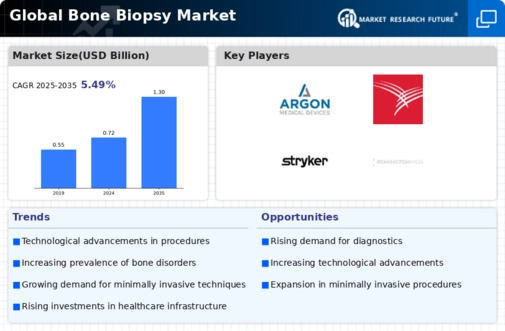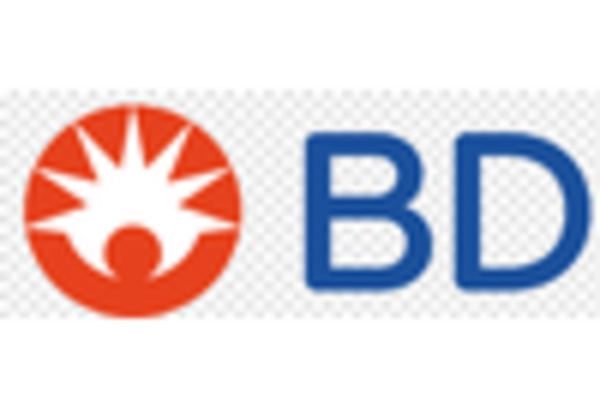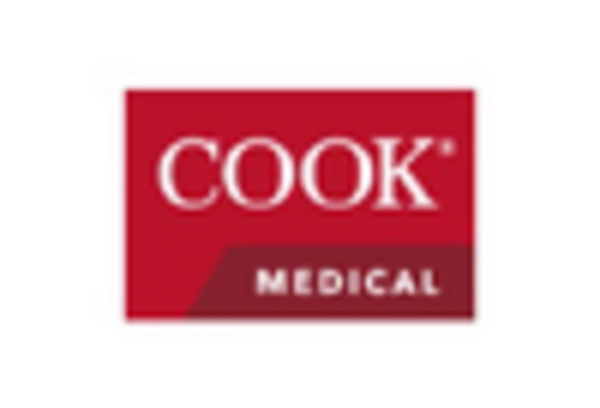Market Analysis
In-depth Analysis of Bone Biopsy Market Industry Landscape
A bone biopsy is a medical test that takes a small sample of tissue or cells from the bone to figure out if there's cancer or bone disease. More people getting bone cancer means more need for bone biopsy tests. The World Health Organization (WHO) says cancer is the main cause of death worldwide. According to the American Cancer Society, in 2022, there will be around 3,910 new cases and about 2,100 deaths from primary cancer of the bones and joints. The American Society of Clinical Oncology (ASCO) says in 2020, about 400 cases of primary bone sarcoma happened in people aged 15 to 19. In the UK, Cancer Research UK says there are about 550 new bone sarcoma cases every year. That's more than 1 case every day. This info shows that bone cancer cases are going up in different parts of the world. If bone cancer isn't found early, it can spread and cause many problems like broken bones, pain, or more serious issues. Bone biopsy is helpful in finding bone cancer in people before it spreads to other parts of the body. It's the best way to diagnose bone cancer. A sample of the affected bone is taken and sent to a lab for testing. Bone biopsy can tell exactly what type of bone cancer a patient has and what stage it's in. The increasing number of bone cancer cases is creating a demand for bone biopsy procedures, and that's boosting the global bone biopsy market.
Bone biopsy is a medical test where a small sample of tissue or cells is taken from the bone to check for cancer or bone disease. More people getting bone cancer means there's a greater need for bone biopsy tests. According to the World Health Organization (WHO), cancer is the leading cause of death globally. The American Cancer Society predicts that in 2022, there will be approximately 3,910 new cases and about 2,100 deaths from primary cancer of the bones and joints. The American Society of Clinical Oncology (ASCO) notes that in 2020, around 400 cases of primary bone sarcoma occurred in people aged 15 to 19. Additionally, Cancer Research UK states that there are about 550 new bone sarcoma cases in the UK every year. This information indicates that bone cancer cases are on the rise worldwide. If not detected early, bone cancer can spread and lead to issues like broken bones, pain, or more serious complications. Bone biopsy is a valuable method for detecting bone cancer before it spreads to other parts of the body. It is the most definitive way to diagnose bone cancer, involving collecting a sample of the affected bone and sending it to a laboratory for testing. Bone biopsy can identify the exact type of bone cancer a patient has and determine the stage it's at. The increasing prevalence of bone cancer is driving the demand for bone biopsy procedures, contributing to the growth of the global bone biopsy market.
A bone biopsy is a medical test that involves taking a small sample of tissue or cells from the bone to check for cancer or bone disease. With more people being diagnosed with bone cancer, there's a growing need for bone biopsy tests. The World Health Organization (WHO) states that cancer is the leading cause of death globally. According to the American Cancer Society, around 3,910 new cases and about 2,100 deaths from primary cancer of the bones and joints are expected in 2022. The American Society of Clinical Oncology (ASCO) reports that in 2020, there were approximately 400 cases of primary bone sarcoma in people aged 15 to 19. Additionally, Cancer Research UK mentions that there are about 550 new bone sarcoma cases in the UK every year. This information highlights the increasing number of bone cancer cases worldwide. If not detected early, bone cancer can spread and lead to complications like broken bones and severe pain. Bone biopsy is a crucial method for detecting bone cancer before it spreads. It is the most definitive way to diagnose bone cancer, involving the collection of a sample from the affected bone and sending it to a laboratory for testing. Bone biopsy can determine the precise type of bone cancer a patient has and its stage. The rising prevalence of bone cancer is generating a demand for bone biopsy procedures, contributing to the growth of the global bone biopsy market.
A bone biopsy is a medical test where a small sample of tissue or cells is taken from the bone to check for cancer or bone disease. The increasing number of people diagnosed with bone cancer has led to a higher demand for bone biopsy tests. According to the World Health Organization (WHO), cancer is the main cause of death worldwide. The American Cancer Society predicts that in 2022, there will be approximately 3,910 new cases and about 2,100 deaths from primary cancer of the bones and joints. The American Society of Clinical Oncology (ASCO) notes that in 2020, around 400 cases of primary bone sarcoma occurred in people aged 15 to 19. Additionally, Cancer Research UK mentions that there are about 550 new bone sarcoma cases in the UK every year. These statistics indicate a growing number of bone cancer cases globally. If not detected early, bone cancer can spread and lead to complications like broken bones and severe pain. Bone biopsy is a critical method for detecting bone cancer before it spreads, involving the collection of a sample from the affected bone


















Leave a Comment